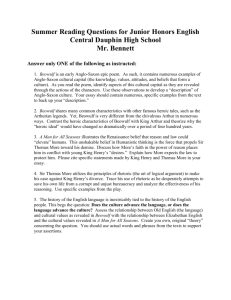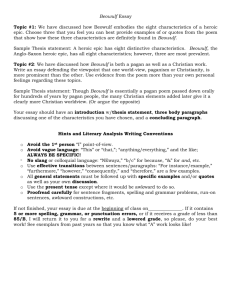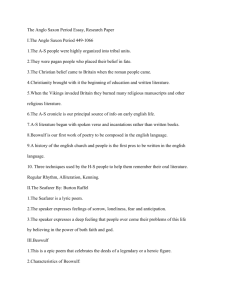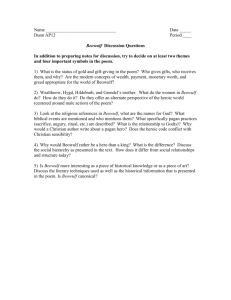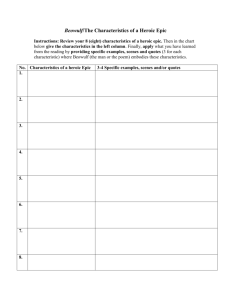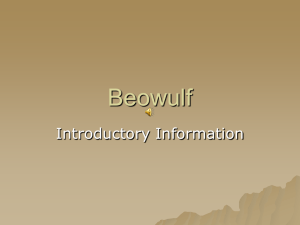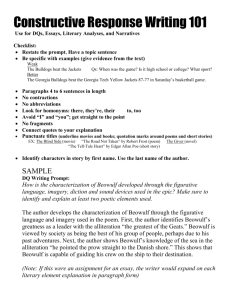Beowulf - TeacherWeb
advertisement
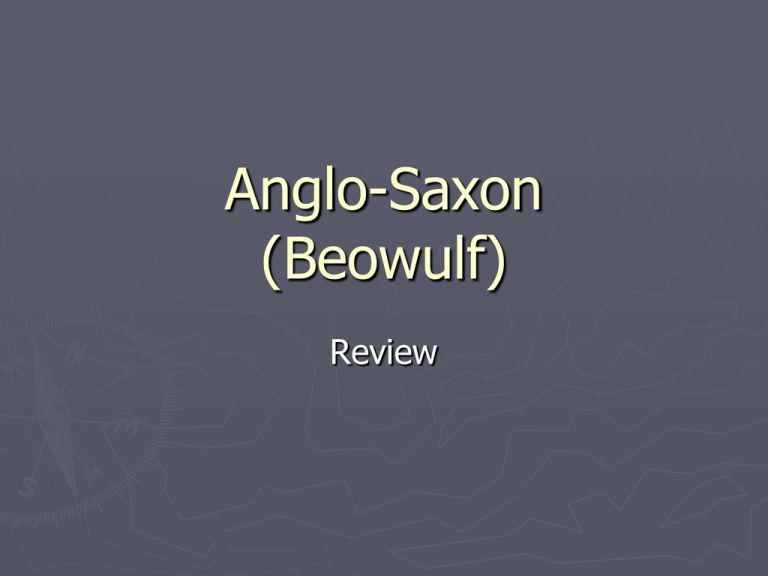
Anglo-Saxon (Beowulf) Review Background Composed around 700 A.D. The story had been in circulation as an oral narrative for many years before it was written. ► The action of the poem takes place around 500 AD ► Poet is reviving the heroic language, style and values and pagan values of ancient Germanic oral poetry ► The poem deals with ancient Germanic forebearers, the Danes and the Geats ► Only a single manuscript of the poem survived the AngloSaxon era. In the 1700’s it was nearly destroyed in a fire ► It was not until 1936 when the Oxford scholar J.R.R> Tolkien published a paper on the poem that it became popular. (who knows who this is?) ► ► The Beowulf Poet ► ► ► ► ► ► The poet is Christian The poem reflects established Christian tradition Allusions to the Old Testament Beowulf is a Redeemer who is sent by God to save man from sin The price of salvation is life itself Correspondences between Beowulf’s death and the death of Christ Heroic Values in Beowulf ► Relationship between king and his warriors ► The king rewards his warriors with gifts ► If a kinsman is slain, obligation to kill the slayer or obtain payment (wergeld) in compensation Conflict Christian Values and Heroic Values ► This tension is at the heart of the poem ► Pagan history and myth are made to point to a Christian moral ► Beowulf is poised between two value systems The Character of Beowulf ► He fights for personal honor, but is committed to service to his own people (his thanes) and humanity. ► A superhuman who remains recognizable ► Contrast old and young Beowulf ► Beowulf as savior Themes ► Good vs. Evil ► Fate ► The Importance of Establishing Identity ► Tension between Heroic Code and Christianity ► Significance of artifacts ► The past Important Elements of the Poem ► Elegaic tone ► Heroic poem ► Contrasts Christian and pagan Youth and old age Rise and fall of nations Joy and sorrow Fate and God’s will Violence Irony Anglo-Saxon Period: 55 B.C. to A.D 1066 Early conquests (before A-S period): Iberians-built Stonehenge (monoliths on Salisbury Plain); brought Stone Age weapons to Britain Celts—farmers and hunters organized into clans with a king (called a chieftain); Druids presided over religious rituals and memorized and recited long, heroic poems Two Celtic Tribes: Brythons (Britons) settled on Britain Gaels settled on Ireland ► Roman Conquest (start of A-S period): Julius Caesar wrote of his raids on islands—first recorded history of Britain (55 BC) Emperor Claudius drove tribes into Wales and Scotland Hadrian built wall to protect n-ern border Britain *Romans ruled Brit for ~400 yrs ► III. A-S Conquest—fierce warriors, skilled seamen: Divided into 3 groups: Angles, Saxons, Jutes—they drove Celts into Wales Celts is where we get King Arthur legend Angles took over lower Brit—they became the English ► A-S England: Recorded Beowulf (1st English epic poem) Tribal society ruled by warring kings—protected by thanes (fighting men who pledged allegiance to him) King rewarded w treasure People gathered royal structures for safety (lg #s); main structure (mead hall) Scop—singing poet for entertainment Bretwaldas—system of ruling kings to reduce chaos Christianity—crucial for development of A-S culture—advanced writing ► Viking Era: Denmark, Norway area—Vik raided Brit 780s (opposed by Alfred the Great) AG est 1st Eng navy AG fortified towns as burhs (bergs). . . . aka suburbs. . . . grid pattern AG studied/translated Latin works, inclu Bede’s history of England into A-S ► VI. Contributions of A-S to Eng—they were the 1st Englishmen!! Provided its language Began its literature Est traditions in law, government, religion ► Beginning of Eng poetry and lit—4 characteristics Love of adventure Emphasis/importance of honor Awe of NATURal beauty Delight in manipulating words (kennings, A-S riddles) *A-S prose was utilitarian (should serve a purpose) rather than imaginative, consisting of histories, lives of the Saints, sermons ► VIII. Kennings--key poetic device of A-S metaphor of 2 words or phrases INdirectly naming something Ring-giver—the king Life-house—the body Swan road—the calm sea, current Whale’s home—sea, ocean ► Sutton Hoo ► Burial site discovered in 1939 ► Important links to Anglo-Saxon world and Beowulf ► Remains of a boat were discovered and large burial chamber containing numerous artifacts ► Artifacts suggest a distinctly Christian element intermingled with pagan ritual. ► Episodes in Beowulf now have tangible archaeological violence to add creditability to the blend of customs in the text. Sutton Hoo Images Themes of Beowulf ► ► ► ► ► ► ► ► ► ► ► ► ► Fame and Glory – What is the difference between the two? Self versus the Wyrd Fortune – What is the purpose of amassing great fortune and fame? What ideal does this uphold in the Anglo-Saxon world? What makes a hero? What do weapons and armor say about the individual? Epic of extreme contrasts. Struggle of human-kind. The Manly Virtues – all are seen in this poem. Comitatus - community of warriors - die to save prince or king. Strict loyalty code. Interlacing Poetry - like a Celtic Knot. Hospitality and loyalty to host and guest. Pride as a sin - Hrothgar warns Beowulf about this - does Beowulf fall into the trap? Heroic Code - tragic
